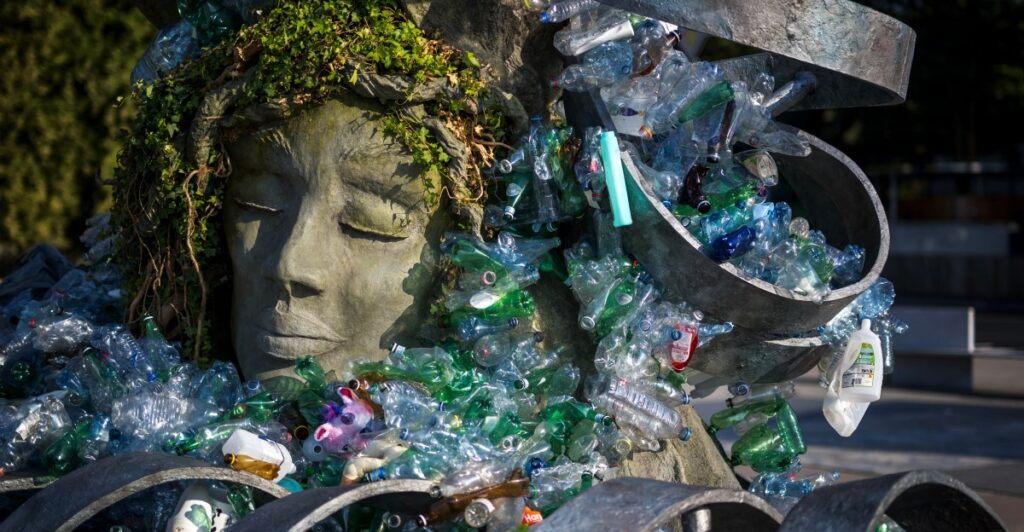
Thousands of delegates have descended upon Geneva this week for what’s supposed to be the culmination of years of negotiations that, if successful, are supposed to end in a groundbreaking global plastics treaty. They might be breathing in the very thing they’re trying to clean up as they negotiate.
Greenpeace tested the air around the city just before the talks began this month and found a small amount of microplastics. It wasn’t so much a rigorous study as it was a way to prove a point. Microplastics are turning up all over the place, including in the air we breathe.
That’s why health and environmental advocates, as well as a coalition of governments, are pushing for an ambitious plastics treaty in Geneva. Recycling isn’t enough — only limiting production can stem the tide of plastic pollution, they contend.
“That you can find microplastics in urban air, that’s not really shocking because it’s been reported before in other cities. I think this is just a way of illustrating that nowhere is free from this pollution,” says David Santillo, a senior scientist with Greenpeace Research Laboratories.
Greenpeace strapped an air-monitoring device to a person while they went about their day in Geneva, spending about eight hours in and out of shops, cafes, office spaces, and a railway station. The samples they collected on July 17th were meant to show what a typical visitor to the city might be exposed to; they weren’t able to take any samples within the negotiation rooms that delegates would actually use.
The device had a replaceable silver filter that Greenpeace researchers were then able to analyze to see what particles they caught, which amounted to at least 165 fibers and fragments. The filters picked up a range of different materials like bits of skin, plant-based fibers, and what was likely soot. Greenpeace was interested in synthetic materials, however, and was ultimately able to identify 12 pieces of microplastics, including polyester, nylon, polyethylene used to make bottles and bags, and other types of plastics. That might not sound like much, but the organization only had the equipment to be able to detect larger particles that were at least 10 microns in size. (For comparison, the average human hair is about 70 microns in diameter.)
“If they found the big ones, it’s a pretty fair bet that the smaller ones were there, as well,” says Philip Landrigan, director of the Global Public Health and the Common Good Program at Boston College, who was not involved in the Greenpeace study.
Generally, the smaller the particle, the more problems it can potentially pose by being able to penetrate deeper into organs and tissues in the human body. A human brain might contain as much as a spoon’s worth of microplastics, research published in the journal Nature Medicine earlier this year suggests.
“Unfortunately, microplastics are pretty much everywhere in today’s world,” Landrigan says. He’s the lead author of an August report, published in the journal The Lancet, on the links between plastic pollution and health outcomes.
“Plastics cause disease and death from infancy to old age,” the report says, adding that plastics are responsible for $1.5 trillion in health-related economic losses each year. The report accounts for all the risks along the lifecycle of plastic, including chemicals that workers and communities near manufacturing facilities are exposed to, and waste that breaks down into nanoplastic particles that have been found in human bodies and breastmilk.
“Plastics cause disease and death from infancy to old age”
Scientists are still working to understand the health impacts of inhaling microplastics in the air. Landrigan points out that we at least know that all plastics are made of two main components, a carbon-based backbone derived from fossil fuels and chemical additives.
“When the microplastic comes into the human body, whether you inhale it or drink it with your water or eat it with your food, when it it gets into you and the plastics move from your gastrointestinal tract into the bloodstream, the microplastic particles are carrying all those chemicals with them,” Landrigan says.
The more than 16,000 different chemicals used in plastics production — including the carcinogen vinyl chloride, for example — are primarily responsible for the known health risks associated with plastics. But the toxicity of more than 75 percent of the chemicals in plastics have yet to be studied.
Greenpeace doesn’t claim to be assessing air quality in Geneva or the health impacts of what they found in their air samples. All they can show is the presence of microplastics in the air, adding to previous research that has done the same. What’s notable now is that Greenpeace has documented this at a time when leaders from around the world have the opportunity to actually do something about it.
Negotiations on a plastics treaty in Geneva are scheduled to end on August 14th. In 2022, United Nations member states agreed to develop a legally binding pact on plastic pollution. It’s been an uphill battle to agree on terms ever since. Major fossil fuel producing nations blocked a deal in December, pushing negotiations past their initial 2024 deadline. So far this year, there’s still a fight over whether focusing on recycling and reducing plastic waste is enough. The fossil fuel industry and countries including the US that produce a lot of plastics and its ingredients are fighting efforts to exclude limits to plastic production from the treaty.
A “high ambition coalition” launched by Rwanda and Norway, on the other hand, wants to address the full lifecycle of plastic, starting with production. It’s also open to using the treaty to phase out or restrict the use of problematic chemicals in plastics.
It doesn’t make sense to simply mop up the mess plastic leaves behind without also turning off the faucet, says Angel Pago, Greenpeace global plastics campaign media lead. “We’re brimming with plastic because of overproduction. And we cannot solve this crisis with just, you know, cleanups,” Pago tells The Verge from Geneva.
The Lancet article similarly says “the principal driver of this [health] crisis is accelerating growth in plastic production.” Production has ballooned from 2 metric megatons in 1950 to 475 in 2022. Less than 10 percent of plastic waste has ever been recycled, in part because the many chemicals used to manufacture different types plastics make it difficult or uneconomical to rehash the material.
“If we’re going to do something about plastics, we need to cap plastic production,” Landrigan says. “I hope and I pray that the treaty negotiators are actually going to produce a treaty that protects human health.”
 Latest World Breaking News Online News Portal
Latest World Breaking News Online News Portal






